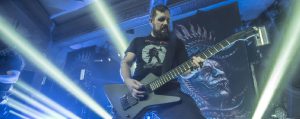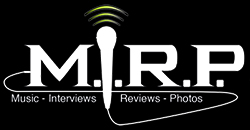To say I was excited for this show is a gross understatement. I had been unaware of Meshuggah until 2004, and only discovered them after Dick Lovgren joined. I’d met Dick back in 2000 when he subbed in for Peter of In Flames at Portland’s other historic venue, The Satyricon (RIP), and I’d always followed his career. From 2004 when I first heard Meshuggah I was a loyal fan. Fast forward to 2016’s The Violent Sleep of Reason, and it was my pick for album of the year (a tie with Gojira’s Magma.)
I arrived at the venue’s downstairs restaurant early, and met some friends for dinner. The venue upstairs, Portland’s historic Crystal Ballroom, is known for its roster of famous musicians passing through, and its floating dance floor.
Just slightly after doors opened at 6:00, MIRP’s photographer, Jerimia, and I arrived at the window. They handed us our credentials, and we were in.
I headed straight to the limited seating upstairs, as I’ve seen Code Orange before, and didn’t want to be in the mosh pit. I secured a front row seat upstairs and watched Toothgrinder.
I’d been excited to see Toothgrinder from what I’d heard of them. They were energetic, and after the first song, I thought: This is going to be great! I knew Code Orange, and of course Meshuggah, and thought…three bands all of such high caliber? Cool! But a few songs in, it took a turn for me. While I found their music to be pretty well done, their energy level high, their look cool, and their “dirty” vocals awesome, their clean singing was off key and didn’t always seem to fit; they didn’t play long as the opening band.
In between Toothgrinder and Code Orange, my photographer messaged me to come downstairs. “No! I’m not leaving this perfect seat,” I replied back. We had a back and forth, and finally, after the fifth or sixth exchange via text, he said, “Trust me.” “Fine” I said. I grabbed his jacket that was holding his seat, picked up my bag of Meshuggah and Code Orange merch I had purchased, and ventured downstairs.
The venue was split in two, with a walkway down the middle for gear to come and go. Facing the stage, to the left was the all ages area; to the right, the over 21 section. Between the stage and the over 21 section was a little sliver that was sectioned off…right at the front of stage left.
I made my way downstairs, and met Jerimia…and he just smiled at me. He walked me past the over 21 section, through a few barricades, and right to that little sliver at the stage. He pointed to my credentials and said, “they allow you in the VIP section.”
I looked at him apologetically and said, “Seriously”? “Yes,” he smiled as he walked away. I looked around and could not believe the location I’d be seeing my beloved Meshuggah! No one in front of me, no moshers, and as close to the stage as you can get. Things like that don’t happen generally without fighting your way through. I wanted to cry, I was so happy.
Code Orange came on with incredible intensity. If you’ve not seen Code Orange, you really should. They do things very differently from most bands. Previously called Code Orange Kids, I can tell that at some point they must had had a sit-down conversation that went something like, “Let’s make our band be as brutal and energetic as we can. Let’s rile the crowd like no one else, and let’s have some heavy breakdowns and some very unexpected time changes. Let’s throw all the traditional heavy metal band elements to the side, and do it as we want.” They succeeded in all of those. Where traditionally, if the vocalist isn’t a stand-alone singer, the vocalist is a bass player or a guitarist. Here, the drummer is the predominant singer. Where most bands have one or two guitarists, they have three. Where most bands have all male members, they have a female member. Where most bands stay on the stage to perform, Code Orange performs wherever they want (maybe on the floor, maybe on top of the crowd, sometimes on the stage).
My favorite part was when one member jumped into the crowd, and security helped him over the barricade after he surfed the fans for a bit. As security lifted him over the barricade, he wrapped his hands around the security guard’s head and kissed him. It was hilarious, but very telling of this very eccentric, appreciative, and energetic band.
The security in this venue may have been a bit ill prepared for the intensity of the Code Orange crowd, but they handled it well. During Code Orange, the number of security personnel doubled. There were a few occasions where someone in the sea of fans motioned to be lifted out of the crowd, and the security was right there to assist.
In preparation of writing this review, I thought a lot about how to describe Meshuggah. First, let me say, it was one of the best live shows I’ve seen in a long time. I see most that come to town, but this one was very special. It is definitely the live show to beat in 2018.
My first instinct was to say that Meshuggah are a behemoth of a band. No that’s not quite right. I’ll try again. Meshuggah are a machine. No, that somehow implies that they don’t have feeling, which is as far from the truth as you can get. The music of Meshuggah is something that you feel. You don’t just hear or see Meshuggah; you feel it. So, let me try again. Meshuggah is a band with members who have an elevated sense of rhythm, tone, and melody, and do it with perfection. Meshuggah are like three organisms. 1) The guitarists who provide the melody and the groove, 2) The vocalist who provides the human feeling and lyrical theme. 3) The rhythm section that distinguishes Meshuggah from every other band. The fact that all three “organisms” are doing something significantly different from the other, is what makes Meshuggah so special…so magnificent.
To my pleasant surprise, Dick Lovgren was just in front of me at stage left. I realized that the majority of the show I had my eyes closed, my head down, and I just felt the music of Meshuggah. The times that my eyes were open, I noticed that Dick plays with his eyes mostly closed also. And, when you watch him play, he is one with his bass, and the music flows through him in a rhythmic pattern that you can see in his movement.
I tried to describe Meshuggah’s music to a friend, and I said it’s like a square pattern but not the same square pattern (I’m not a musician, obviously). You can tap your foot or nod your head to it, but when you know the music, it is the most satisfying thing because it’s not predictable or uniform. So, as I struggled to explain it to my friend, we looked it up on Wikipedia, and we read it together: “Trademarks and characteristics that define Meshuggah’s sound and songwriting include polyrhythms, polymetered riff cycles, rhythmic syncopation, rapid key and tempochanges and neo-jazz chromatics. In polymeters typically used by Meshuggah, the guitars might play in odd meters such as 5/16 or 17/16, while drums play in 4/4. One particular example of Haake’s use of polymeter is 4/4 against 23/16 bimeter, in which he keeps the hi-hat andride cymbal in 4/4 time but uses the snare and double bass drums in 23/16 time. On “Rational Gaze” (from Nothing), Haake plays simple 4/4 time, hitting the snare on each third beat, for 16 bars. At the same time, the guitars and bass are playing same quarter notes, albeit in a different time signature; eventually both sides meet up again at the 64th beat. Hagström notes about the polymeters, “We’ve never really been into the odd time signatures we get accused of using. Everything we do is based around a 4/4 core. It’s just that we arrange parts differently around that center to make it seem like something else is going on.”
Besides the occasional band member switching sides, the members of Meshuggah don’t move around very much. They instead employ a light show that is spectacular, and movement isn’t ne

eded; the music does all the talking. While I didn’t personally see it, someone said there were signs posted in the venue that warned of a potential for seizures. And, I’ll admit, that when my eyes were open, there were times where I shut my eyes due to the intensity of the lights.
Often, the band members looked like black statuesque figures amidst the most beautiful background of lights. Sometimes the red, blue, purple, pink lights engulfed the members, sometimes they were a symmetrical pattern, sometimes strobes, consistently synced perfectly to the music.
While the venue was packed, it felt like an intimate show for me. And, I think that is what is so special about the music of Meshuggah. It is intimate. It is personal. It is emotional. It is exquisite.
A night like this from a band of this caliber cannot be easily duplicated or beat. I must say it was a very special night.

